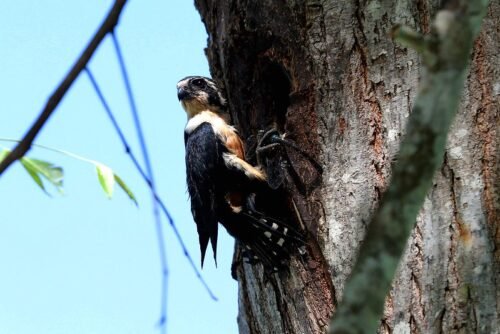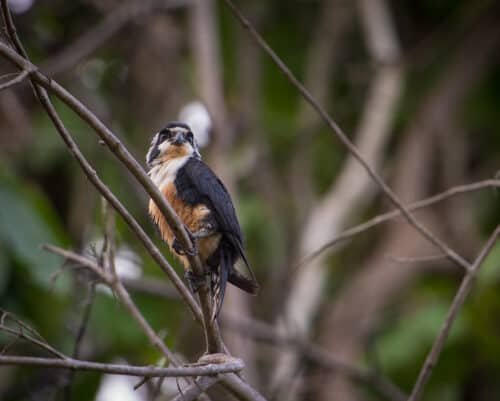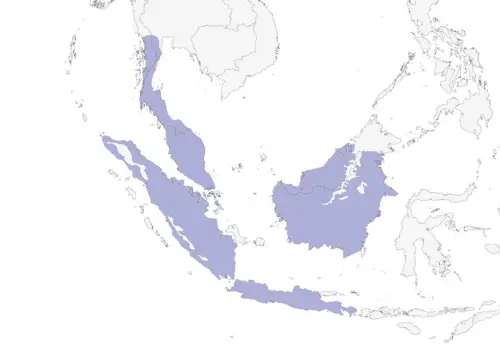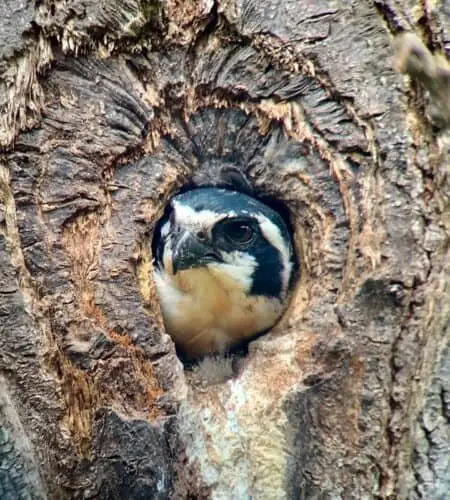The Black-thighed Falconet (Microhierax fringillarius), is the world’s smallest bird of prey. Measuring only 5 to 6 inches in length and weighing a mere 1 to 2 ounces, this petite raptor is a true marvel of the animal kingdom.
Native to Southeast Asia, the Black-thighed Falconet is an agile hunter, feeding primarily on insects and occasionally small birds and reptiles.
Despite their tiny size, these birds have big personalities, exhibiting monogamous behavior and fiercely protecting their young. Let’s dive into the fascinating details of this amazing little predator!

Size and Appearance
Let’s start by discussing the Black-thighed Falconet’s diminutive stature.
Measuring a mere 5 to 6 inches (13 to 15 cm) in length and weighing in at a lightweight 1 to 2 ounces (35 to 50 grams), this bird is smaller than many songbirds. But don’t let its size fool you; this tiny terror packs a powerful punch in the world of raptors!
The Black-thighed Falconet’s plumage is predominantly black and white, with a black cap, white cheeks, and a white collar. Its black thighs (hence the name) contrast with its white underparts, creating a striking appearance. A pair of piercing dark eyes adds to its formidable presence.

Habitat and Distribution: Where to Find the World’s Tiniest Raptor
The Black-thighed Falconet can be found in Southeast Asia, specifically in countries like Thailand, Malaysia, and Indonesia. This bird prefers open habitats, such as lowland forests, forest edges, and even cultivated areas. In these environments, it makes its home in tree cavities, often taking over nests previously used by woodpeckers or barbets.

Diet and Hunting: The Tiniest Predator in the Skies
Incredibly agile and swift, the Black-thighed Falconet is a skillful hunter despite its small size. It primarily preys on insects, such as dragonflies and butterflies, but it’s also known to occasionally catch small birds and reptiles.
The falconet’s hunting technique is quite impressive: it perches on a high branch and scans the surrounding area for potential prey. Once it spots its target, it swoops down with incredible speed and precision, snatching up its meal with its sharp talons.
Social Behavior and Breeding: Tiny Raptors with Big Personalities
Black-thighed Falconets are known for their monogamous nature and often mate for life. During the breeding season, the male and female work together to build their nest in a tree cavity, lining it with leaves and feathers to create a cozy environment for their future offspring.
The female lays a clutch of 3 to 5 eggs, which she incubates for around 3 weeks. Once the chicks hatch, both parents take turns feeding and caring for their young until they’re ready to fledge, around 4 weeks later. Despite their small size, these little birds are fiercely protective of their young and will defend their nest against intruders.

Conservation Status: Protecting the Pint-Sized Predator
The Black-thighed Falconet is currently listed as a species of Least Concern by the IUCN Red List. However, habitat loss and deforestation are ongoing threats that could impact its populations in the future.
To ensure the survival of this unique species, it’s essential that we continue to protect their natural habitats and raise awareness about their importance.
Conclusion: The Black-Thighed Falconet – Small but Mighty!
The Black-thighed Falconet is an awe-inspiring example of how size doesn’t always matter when it comes to being a formidable predator.
